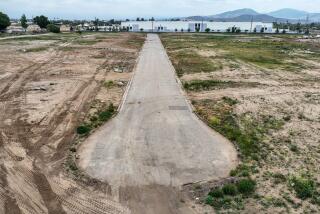Relocated From Downtown Oceanside : Rail Yard Has High-Rise Residents Seeing Red
- Share via
When Skip Arthur purchased a two-bedroom luxury condominium at Oceanside’s Marina Towers back in 1979, he thought he had found paradise on the seventh floor.
Perched in the exclusive high-rise near the peaceful backwaters of the city’s harbor, Arthur can see as far south as La Jolla. To the west, the Pacific Ocean glimmers. Looking north, the rolling chaparral of Camp Pendleton unfolds to the horizon.
Now a newcomer to the neighborhood will change that view. A railroad switching yard is under construction in the shadow of the 17-story condominium tower. Any day now, Arthur and other Marina Towers residents expect to gaze down from their balconies and find freight cars and hobos marring the view.
“Hell, it’s right at our back door,” Arthur said one recent day while surveying the network of tracks being assembled below. “They’ve put it right next to the most valuable asset this city has--the harbor. It doesn’t make sense.”
Hoping to scuttle the project, the Marina Towers Homeowners Assn. has been fighting the city in court for nearly two years. In early December, however, the Fourth District Court of Appeal ruled against the association. Undeterred, the group’s leaders say they plan to take the rail yard issue to the state Supreme Court.
Oceanside city officials aren’t about to concede the battle. They’ve worked long and hard to see the freight switching yard moved from its longtime location in the heart of downtown to the 16-acre site on Camp Pendleton just north of Marina Towers.
For years, the switching yards have been something of a burr in the side of the city’s redevelopment efforts. As trains chugged back and forth on the five sets of tracks, two key access routes to the beach were blocked as many as 99 times a day, snarling traffic and prompting safety headaches.
Moreover, city officials say the freight yard served as a magnet for criminal activity and represented a troublesome eyesore, damaging the best-laid plans of the redevelopment agency to market the downtown area.
Every major developer who has expressed interest in downtown Oceanside has indicated a reluctance to build in the city if the switching yard was not moved from its site just three blocks from the beach, officials said.
“Without being hyperbolic, it probably was the most critical component for the success of redevelopment in downtown Oceanside,” said Margueretta Gulati, the city’s redevelopment director. “It removed the major obstacle to redevelopment, the major impediment to access from the freeway to the beach.”
After years of effort and sensitive negotiations, redevelopment officials in 1984 finally hammered out an agreement with the military and the Atchison, Topeka and Santa Fe Railroad to move the yard to a site near Interstate 5 on Camp Pendleton. In addition, the agency’s leaders had to work long hours to secure federal and state grants to help defray the cost of the $4.5-million project.
Construction of the switching yard began about a year ago at the site, an area bounded by Harbor Drive on the south, Interstate 5 on the east, the Wire Mountain overpass on the north and the railroad main line on the west. The new yard is scheduled to be completed this spring, after which the existing freight facility in downtown Oceanside will be demolished, opening up 22 acres there for development.
The prime downtown land is being spotlighted as the potential site for a hotel, commercial shops, restaurants and parking. Redevelopment officials say the railroad has already been approached by about half a dozen developers interested in building on the property.
Though sympathetic to the city’s desire to move the switching yard from downtown Oceanside, Arthur and his neighbors say their backyard is no place for the railroad operation.
As they see it, the yard will not only scar the unblemished North County panorama that they have long enjoyed, but also cause crime problems by attracting vagrants, illegal aliens and others who ride the rails.
Moreover, they worry that noise and pollution from the freight trains, as well as the large truck-and-trailer rigs expected to frequent the yard, will pose a problem.
Finally, the Marina Towers residents suggest the facility will prove to be an unsavory welcome mat at the city’s northern boundary for visitors traveling south on I-5. If anything, they say, the freight yard should have been relocated to a site on Camp Pendleton several miles to the north, far from Oceanside.
“It’s just like a breeding ground for problems” Arthur said. “Now they’re concentrated downtown, but soon they’ll be right next to us here. They’ve removed the blight from the downtown and put it right next door.”
Fred Abboud, a resident of Marina Towers since 1977, agreed.
“This is a beautiful building, a beautiful spot to live,” Abboud said. “There’s nothing like this building on the coast around here. Now, to put a railroad yard right next to it, that is very bad.”
Oceanside officials counter that the new switching yard will cause few of the problems envisioned by residents of Marina Towers, where a two-bedroom unit sells for about $250,000.
Gulati said an environmental review indicated that noise from the yard will not pose a headache for residents in the 67-unit building, especially because the freight train operations will be limited to daylight hours.
In addition, the freight yard will be “much more contemporary” than the downtown facility, making it less of an eyesore, she said. Trees are to be planted around the perimeter of the site to block it from ground-level view. As for residents in the tower, most have only a “peripheral view” of the yard at worst, Gulati said.
Because the yard is on the locked and guarded military base, it will be inaccessible to vagrants and will not become a nurturing ground for crime, she said.
“The military doesn’t exactly allow people to stroll onto their property,” Gulati said. “We think the residents’ concern about crime because of the yard is unfounded.”
Moreover, Gulati pointed out that the switching yard could prove to be the lesser of evils for the Marina Towers residents. The military easily could have decided to use the property for something even more unsightly than several sets of railroad tracks, she said.
“That land could have been covered with tanks, industrial uses or just about anything else that suited the needs of the military,” she said. “We were in no position to tell the Marines to keep that land a pasture because it’s near our harbor.”
After the condominium residents began complaining about the switching yard relocation project in October, 1984, a meeting was arranged with Gulati and other city officials. When no agreement could be reached, the homeowners association filed suit against the redevelopment agency in January, 1985.
The lawsuit alleges the city violated state law when it said the switching yard posed no detrimental environmental impact on the residents. In addition, the suit contends the city violated the residents’ due process rights by failing to adequately notify them of the plans to build the freight facility.
“We didn’t know about it, and that was the problem,” said Allen Crews, outgoing president of the Marina Towers Homeowners Assn.
Gulati insists the redevelopment agency used the proper procedures for notifying residents of the meeting, noting that the issue was widely publicized in the local press. But Crews said many residents use their units only as a second home and do not read local papers.
The homeowners lost in Superior Court and then lost again before the appeal court. In that Dec. 2 opinion, Justice Howard Weiner pointed to the responsibility of the city to weigh the rights of the Marina Towers residents against those of the city as a whole.
“To be sure, one significant factor to be considered by the public entity is the effect the improvement will have on surrounding properties,” Weiner wrote in the opinion. “But the entity must then balance those effects against the benefits accruing to the public generally as a result of the improvement.”
Despite the recent setback, Crews said the association would press on.
If anything, Crews said, he would like to see the city meet the residents halfway by providing additional fencing and security gates for the condominium complex’s parking lot.
But Gulati said such a compromise is unlikely.
” . . . For them to come back after losing repeatedly in court and say they’re ready to make an out-of-court settlement is a day late and a dollar short,” Gulati said.
Arthur, meanwhile, wishes city officials would simply see the error they’ve made and try to do something about it.
“There’s good spots for train yards and there’s bad spots for train yards,” he said. “This is one of those bad spots.”
More to Read
Sign up for Essential California
The most important California stories and recommendations in your inbox every morning.
You may occasionally receive promotional content from the Los Angeles Times.










